Greenhouse Guide – What You Need to Know Before You Build
This post may contain affiliate links. Read my full disclosure here.
We’re going to give you the information you need to choose the right greenhouse option for you. We’ll talk about costs, types of greenhouses, location, and planning for operation.
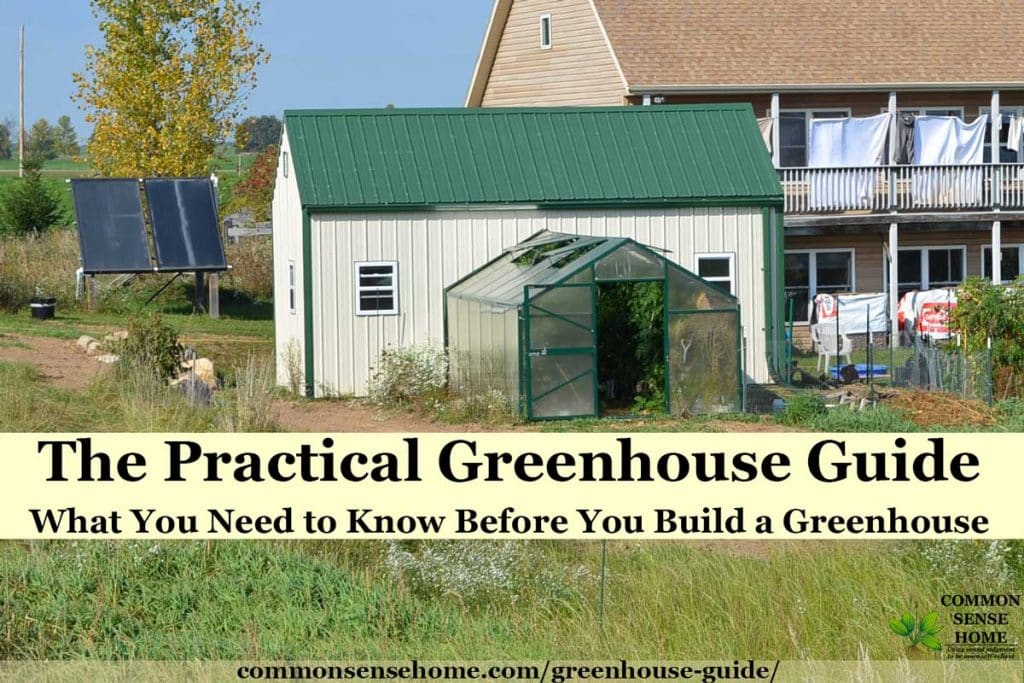
What is a greenhouse?
A greenhouse is a building with clear walls where plants are grown to protect them from cold weather or other environmental issues (such as pests).
You can add extra heat to your greenhouse, or count on the sun to get the job done. Climate battery greenhouses (like those discussed in “The Forest Garden Greenhouse“) store heat underground or in barrels to grow tropical plants in temperate growing areas.
Be careful – there are a ton of DIY options online, but many won’t hold up to extended use, or they skip some recommended components (like good ventilation).
Greenhouse Cost and Types
There are many different ways to extend your growing season, and they can vary dramatically in cost, size and complexity.
Figure out your budget, how you would like to use your greenhouse (protecting transplants, potted plants or a year round growing environment), and how much space you need.
A greenhouse can save you money by reducing your grocery bill, so it’s not just an expense, it’s an investment.
Low Priced Frost and Freeze Protection (Small and Budget Greenhouses)
- Row covers are functionally very small greenhouses, covering a single planting row.
- Build your own cold frames (also referred to as a “hot bed”)
- Windows, plastic sheeting or polycarbonate panels can be used over openings
- Collect old windows shower doors and patio doors to use as part of your cold-frame
- A cold frame acts as a “mini-greenhouse”
- A “lean-to” greenhouse is similar to a cold frame, but is larger and sloped.
- Small portable greenhouse these get hot and make sure you anchor them.
Cold frames are easy to put together with recycled windows and wood.
Mid-Priced (Small to Medium Sized Greenhouses)
- Small polycarbonate kit
- Window greenhouse (indoor)
- A-Frame or Barn structure
- Gothic arch
- Hoop house
- Do it yourself hoop house using PVC and plastic
- Do it yourself 2×4 stud frame greenhouse and plastic
High Price (Medium to Large Greenhouses)
- High Tunnel and Hoop house
- Medium and large greenhouse kits
- Formal Gothic and conservatory
- Multi wall hoop house or polycarbonate building
- Attached 4 season room (indoor)
Locating the Greenhouse
Whether you choose to build your own greenhouse, assemble a kit or have one built professionally, you still need to pick the right place to put it. Use the list below to help select your location.
Ordinances, Permits and Restrictive Covenants
Make sure there are no local ordinances, permits or restrictive covenants that would impact building a greenhouse.
Soil
Try to find a flat area that isn’t likely to see flooding or heavy runoff. If you want to have plants grow directly in the soil of your greenhouse, do a soil test. Watch out for contaminants in the soil that you don’t want in your food.
If you’re planning to have a concrete slab put down and mount your greenhouse on the slab, then soil is not concern. If you want to skip the slab, see “Build a Secure Foundation That Preserves Your Growing Space“.
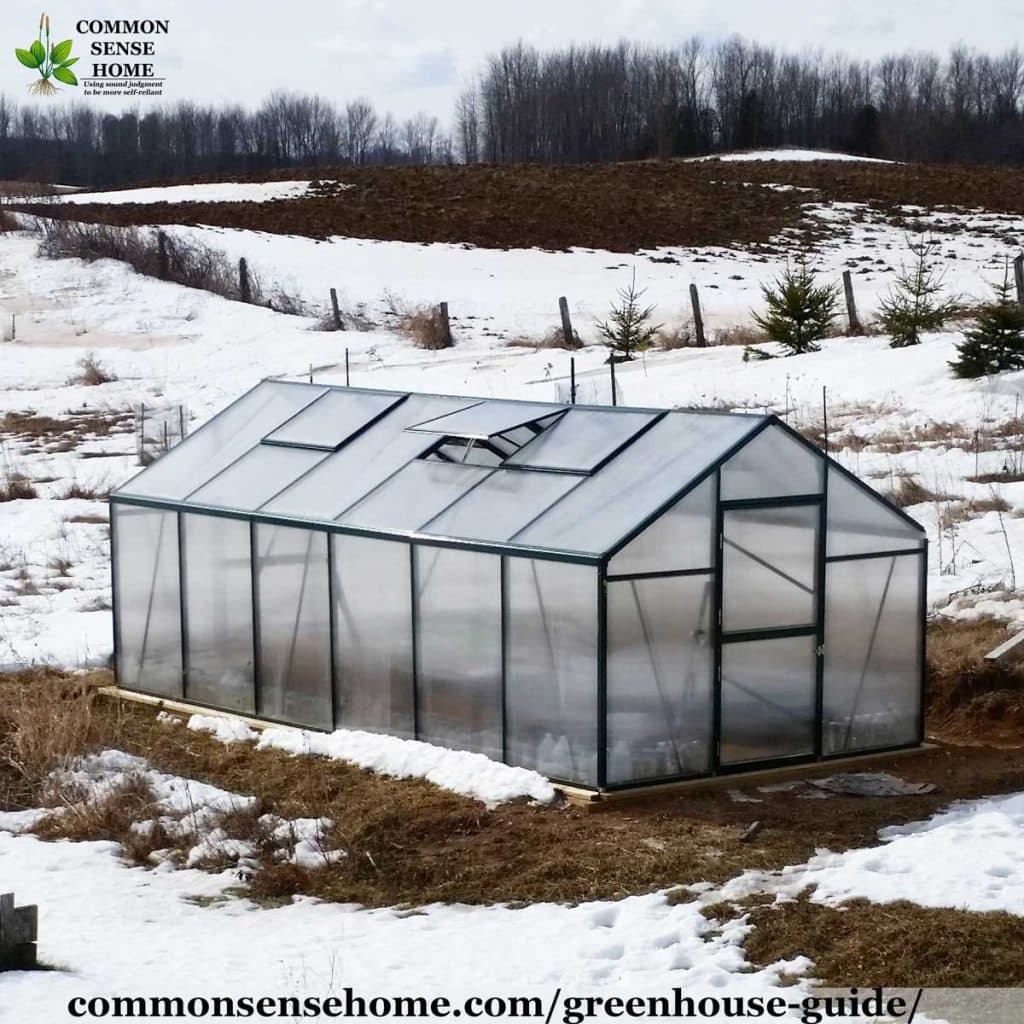
Snow
Remember that snow can build up on and around the greenhouse. The building can create a melt and freeze cycle that may damage a poor foundation.
Snow is also heavy, so plan to remove excess snow or build strong enough that it won’t collapse.
Sunlight
Make sure the greenhouse has full sunlight, especially in colder areas. Pay attention to sun angles at different times of the year. The sun is higher in the sky at mid-summer, and lower at other times of the year.
Water and Electricity
Locate the greenhouse with access to water. You will need to water by hand, set up drip irrigation or a sprinkler system. Frost proof if needed to prevent cold damage.
If you want power for irrigation, light or heat, plan accordingly.
Wind
A greenhouse needs to be anchored and aligned to the wind if you have regular high winds. Wind protection can include a treeline or other windblock, possibly even an earth berm.
Keeping Your Greenhouse Working – What to Plan For During Operation
There are a number of things that are critical to the construction and use of nearly any greenhouse.
Overheating and Ventilation
The intent of a greenhouse is to capture heat, but it can get too hot in warm weather. You need manual or automatic ventilation, or your plants will die.
Low airflow, excess humidity and high temperatures can also lead to mold, powdery mildew and other plant diseases.
Pest Control
Pests enjoy sheltered conditions as much as your plants.
Common greenhouse pests include:
- Aphids
- fungus
- gnats
- cutworms and other caterpillars
- whiteflies
- shore flies
- slugs
- bloodworms
Mice, shrews and snakes may also move in.
See The Ultimate Guide to Natural Pest Control in the Garden and The Best Ways to Get Rid of Mice for control tips.
Good Bugs, Fungus and Critters
You need pollinators for fruiting vegetables, flowers and fruits. Other beneficial insects can help control pests.
You may also want to inoculate the soil or plants with mycorrhizal fungi, to help establish a healthy ecosystem. Welcome worms and other healthy soil dwellers with plenty of organic matter in your soil.
Watering
Check soil moisture regularly, and water as needed to make sure your plants don’t dry out.
Soil
Regularly test your soil and amend as needed. Extra organic matter helps retain moisture. See “Organic Fertilizers – How to Feed Your Plants, Soil and Microbes” for soil building tips.
The ideal pH range depends on what you are growing. For generic vegetable garden plants, go for 6-7 pH.
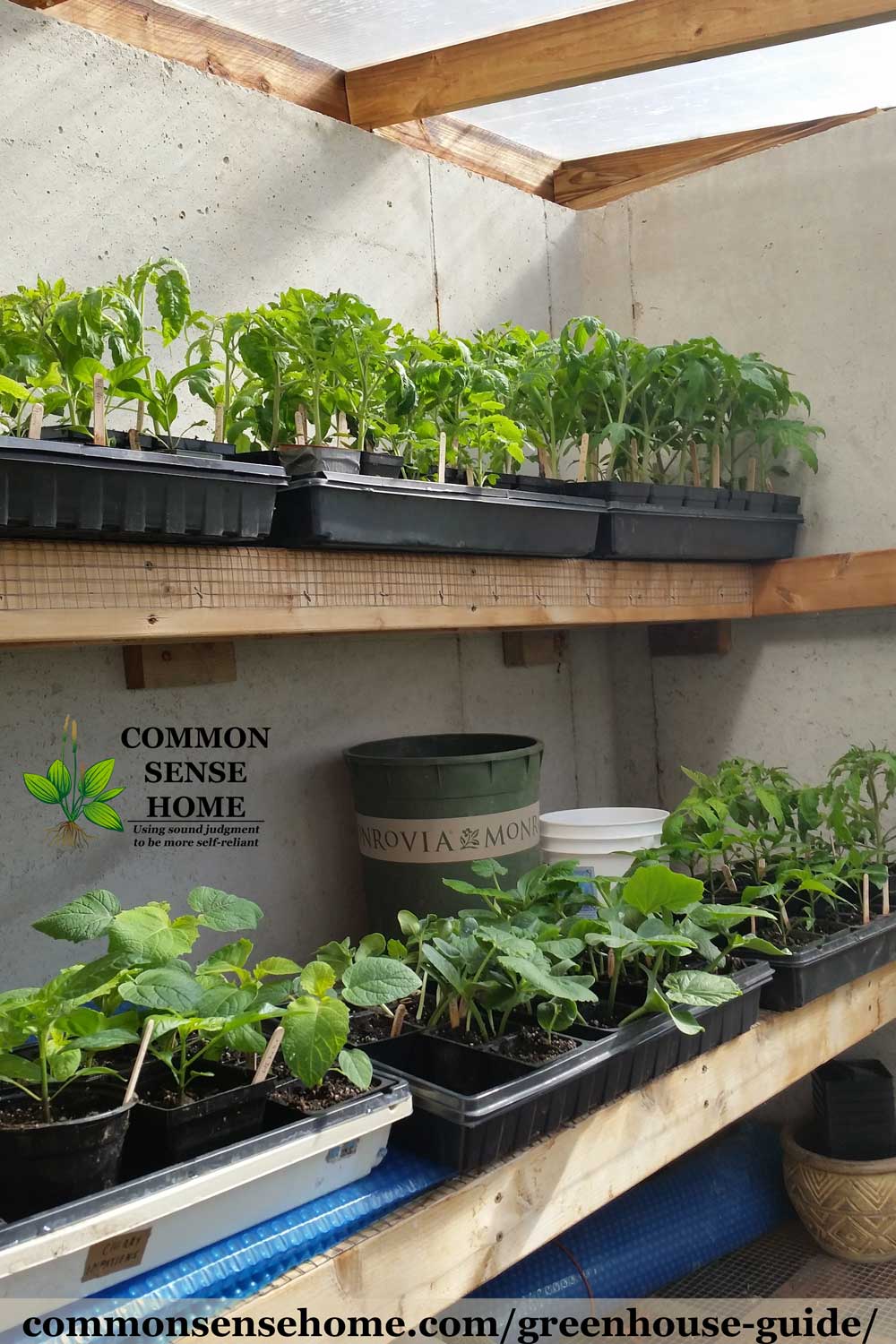
Greenhouse shelving
Shelves should be rust and rot resistant, and include drainage. Some options include:
- Metal shelving with powder coating and drainage holes
- wood plants on cinder blocks
- Wire mesh fencing over wooden frames
If you build out of wood, consider cedar to avoid rotting. We don’t recommend using green treat in the greenhouse, shelving as the chemicals can leach out of the wood, onto the plants and into your food.
Build shelves that match the 11″ by 22″ standard plant trays, or your planting containers of choice.
Greenhouse Sidewalls
In northern climates with heavy snow, you might want a solid side wall that is 2 to 4 feet high. Some wall options include metal siding, wood panels, or cinder block.
This can also provide some protection from critters (raccoons, rabbits etc), especially if you put it a foot+ below the ground level.
Would you like to save this?
Heated & Insulated Greenhouses
A greenhouse that can protect from below zero temperatures needs a heat source. Heated greenhouses are also known as a warm house, hot house or a conservatory.
Heat Sources
Greenhouse heat sources include: hydronic heat (in floor heating), geothermal, hot compost beds, electric fan heaters, propane or natural gas heaters, wood fired rocket heater or even a simple Ben Franklin stove.
Fires are more complicated and create higher temperature swings. A rocket mass heater or masonry stove releases heat more slowly, but takes up potential growing space.
Powered heaters on a thermostat are simple, but expensive. Hot compost beds are limited in the heat they produce.
Insulation
You can provide an extra layer of frost protection with row covers (blankets, sheets or “horticultural fleece”) on particularly cold nights, creating a “greenhouse within a greenhouse”.
For small greenhouses, bubble wrap works as a good insulator to reduce heat loss, and still allows some solar gain.
Double Walls
In colder climates, a double wall greenhouse can reduce heat loss. Basically, it’s a greenhouse with two layers of covering. The air trapped between the inside and outside layers of plastic acts as extra insulation.
This costs more, and creates some summer venting challenges, but does reduce heat loss considerably.

Thermal Mass
Thermal mass absorbs heat during the day and releases it at night. This mass can be earth, water jugs or large water drums.
Earth Sheltering
The soil below the frost line maintains a fairly steady temperature year round. It also acts as insulation, and helps keep the greenhouse from falling below freezing.
An earth sheltered greenhouse is also known as a “walipini”.
Don’t expect a magical tropical oasis from digging a hole in the ground and covering it with plastic. “Build this underground greenhouse for only $300” is not a working reality for most people.
Near our home here in northeast Wisconsin, a friend built a fully earth sheltered greenhouse on the south side of her garage.
She added many 50 gallon drums filled with water for thermal mass and a makeshift climate battery and a multiwall polycarbonate cover. It still dropped below freezing, and all but the most cold hardy plants died.
“Underground” or earth sheltered greenhouses can also suffer from flooding and collapse. Please do plenty of research if you want to try this option.
Earth Berm
Traditionally, a greenhouse is fully bermed or earth sheltered the north side (south side in the southern hemisphere) and partially protected on the east and west sides.
The earth berm provides insulation, wind protection and thermal mass, but also complicates the construction. It may not be appropriate for suburban or urban locations due to space constraints.
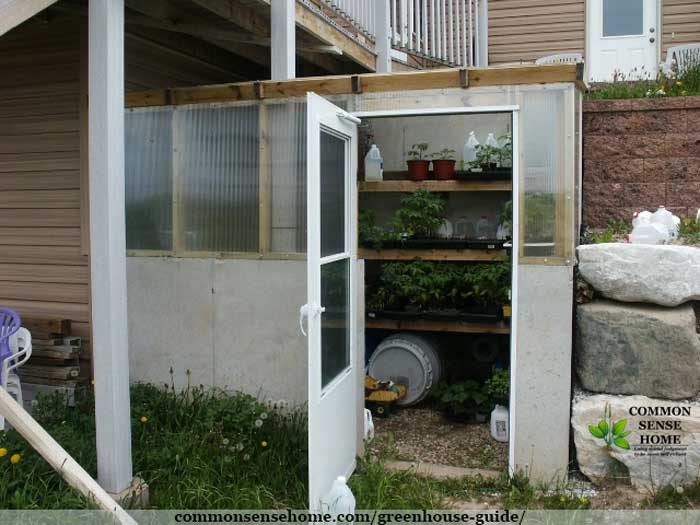
Attached Greenhouse
Another simple trick to keep a smaller greenhouse warm is to build it attached to a home. You open the door between the two areas on cold nights, and let the home heat the space.
Be sure to have a screen door, unless you have cats that like to hunt mice indoors. (As we mentioned earlier, mice love warm, cozy planting areas, too.)
Since they are easy to access, you’re more likely to visit regularly to maintain and enjoy your plants.
Another option is to attach a greenhouse to a shed or outbuilding. The outbuilding also gives you a place to store tools and other gardening items, and can act as an airlock.
Advanced Greenhouse Concepts
Hydroponics and Aquaponics
Hydroponics is growing plants without soil. The plans are grown in water that has nutrients and minerals. In many cases hydroponics are combined with fish production, resulting in aquaponics.
For hydroponics or aquaponics, you need electricity, heat, and water.
See Introduction to Aquaponics: Growing Fish and Vegetables Together for more information.
Chickens, Coops and Greenhouses
If you search you will find examples of chicken coops linked to a greenhouse. Use this option with caution.
Chicken poop is high in nitrogen and can burn plants, and anyone with chickens knows how they like to dig. It’s best to compost your chicken poop before using it in your garden, to reduce the risk of disease transmission.
In The Small Scale Poultry Flock, Harvey Ussery portions off a part of his greenhouse for chickens, which is a much more practical option. With this setup, you can allow your chickens access during the off season to work the soil and clean up bugs.
We have our coop connected to the greenhouse, and the runner ducks use it as a winter shelter.
As the weather warms, the ducks head back outside during the day, and their droppings are worked into the soil. (Duck droppings have lower nitrogen levels than chicken droppings.)

Greenhouse Sheathing (Covers)
Plastics
Greenhouses can be closed in with glass, plastic panels, multiwall polycarbonate panels, and sheets of plastic.
The sheets of plastic are measured in MILs. MIL refers to the millimeter thickness, with higher numbers being more durable.
- 4 mil is likely only good for 1 year
- 6 mil plastic can last a few years
- 12 mil is better for the large “high tunnel” hoop houses
There are custom plastic films that may provide better tear resistance, and solar resilience over time. It should note in the product description that it is greenhouse plastic.
Note: The USDA has a grant program to help farmers afford hoop houses for food production. You can learn more at the High Tunnel System Initiative home page.
Glass
Glass is a good greenhouse cover. It lasts longer than plastics, but costs more.
Least Expensive: Regular or annealed glass breaks more easily than others, and will break into jagged shards, creating a hazard for anyone nearby.
Moderately Expensive: The next better option is tempered glass. It is 4 to 6 times stronger than regular annealed glass, breaks into small square fragments, and handles big temperature changes.
Most Expensive: Laminated glass is dual layer (two sheets of glass bonded together) using a PVB (polyvinyl butryal) between the layers of glass. The windshield of cars and trucks are laminated, making them extremely strong and it wont easily break into pieces. It is good for roofs and other high load, or high impact surfaces.
Note: Regular double pane or triple pane windows are not the best choice for a greenhouse. The warranties for most regular windows are void if used in this way.
If you are using salvaged windows, be aware that they may be more prone to fogging, especially if the seals are broken.
Also, modern house windows often have UV blocking coating, which means less light transmission to your seedlings. This slows down plant growth.
Older windows may have lead paint, which makes them unsafe to use near food.
Free Greenhouse Reference Information
- Missouri greenhouse operations guide. Detailed free reference that includes designs and identification of insects.
- Design and Layout of a small commercial greenhouse operation
- Hobby Greenhouses in Tennessee
- Community Garden Guide Season Extension Hoop Houses
- Constructing a Low-cost High Tunnel
- Greenhouse Care guide
Need More Gardening Information?
If you have gardening questions or comments, just leave a message below.
We invite you to check out the full list of garden posts on the site on the Common Sense Gardening page.
Originally published in 2018, last updated in 2020.

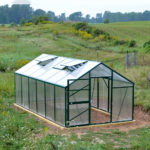
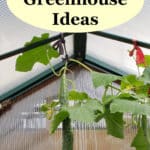
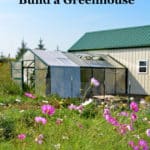




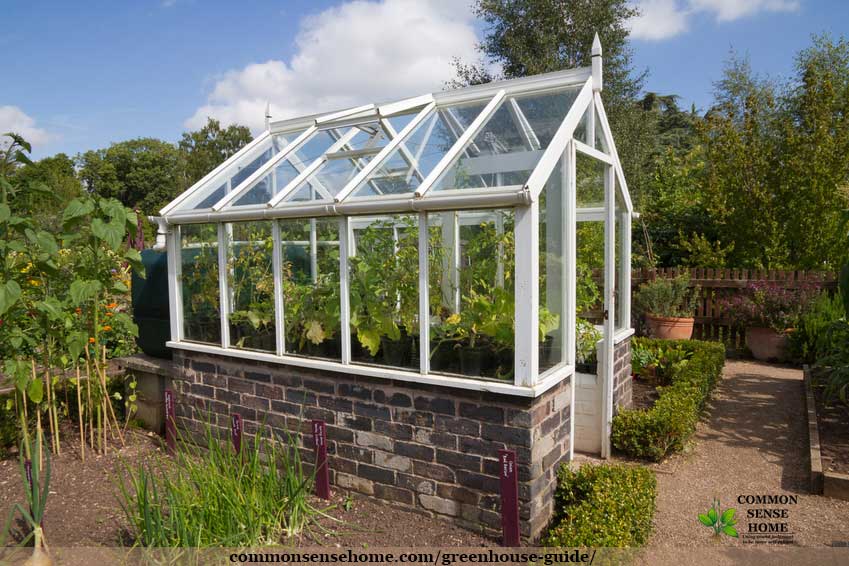

Hi Laurie,
We are building a lean-to greenhouse against our wood shed with a wood frame and polycarbonate panels. I’ve never had a greenhouse before and am confused about growing vegetables that need to be pollinated in there. If I wanted to grow some tomato plants, for example, do you leave the door/vents open to let pollinators in or do you hand pollinate? If I leave the door/vents open with no screens then other pests can get in also, which is something I am trying to avoid. What do you in your greenhouses? I am in Wisconsin, like you, and won’t be heating the greenhouse in the winter. Also, do you start your seeds in your greenhouses?
You will need ventilation, as the temperature inside a greenhouse can spike very quickly when the sun comes out. (You’ll want a thermometer in it, too.)
The easiest way to ventilate is to open a door, window, or roof vent. We open roof vents and doors, so pollinators have plenty of access.
As for keeping pests out, I’m not concerned about them. If your soil and plants are vigorously healthy, they won’t be attractive to pests. I know it sounds crazy, but it’s true. I’ve seen it in our garden as the soil has improved during the years we’ve been here. If pests do show up, there are plenty of non-toxic ways to deter or eliminate them. You could try using screening (like a screen door or screens over openings), but it would be awkward. Still, that’s up to you.
I’m going to have a more detailed garden pest guide coming out next month, with step by step strategies for specific pests, but you can access the basic guide right now at https://commonsensehome.com/garden-pest-control/
I start seeds inside under grow lights because I can control the conditions more (and because our ducks have access to the main greenhouse during winter). Then I move the seedlings out to the greenhouse once temperatures are in their preferred range. If we didn’t have the ducks getting into mischief, I’d start cold tolerant crops out there. Before we had the ducks, we’d have cold tolerant self-seeded greens popping up as early as February, though they didn’t grow quickly due to lack of light that time of year and temperature swings.
Check out a habitat for humanity r something like that. They may even donate the materials to you!
I am a special education teacher.
Students saving for a greenhouse that is sturdy (weather worthy), and will have longevity.
Size about 12×20 feet. Recommendations of what we should set our sights on (price, manufacturer)?
Grateful for honesty.
I’d shop around and compare current reviews and pricing. With all the supply chain disruptions, prices on many items are much higher than they used to be. I’m afraid it’s only going to get worse.
I’d go for glass or multiwall polycarbonate if you want something that will last for many years. A hoop house with thicker plastic may last 3-5 years, depending on conditions, before the plastic covering needs to be replaced. Make sure to plan for ventilation.